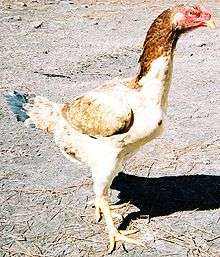Malay chicken
|
| |
| Other names | Malay |
|---|---|
| Traits | |
| Weight |
Male: Standard: about 5 kg Bantam: 1190–1360 g[1] |
|
Female: Standard: about 4.1 kg Bantam: 1020–1130 g[1] | |
| Classification | |
| APA | all other standard breeds[2] |
| ABA | all other comb clean legged |
| EE | yes[3] |
| PCGB | Asian hard feather[4] |
|
Chicken Gallus gallus domesticus | |
.jpg)

The Malay is a breed of game chicken. It is the tallest breed of chicken, and may stand over 90 cm high.[5] The Malay is bred principally in Europe,[3] and in Australia and the United States.[6] It was derived, partly in Devon and Cornwall in south-west England,[7] from birds imported from Indian subcontinent[5] or South-east Asia in the first decades of the nineteenth century, when large birds of this type were widespread in northern India, in Indonesia and in the Malay Peninsula.[8]
The Malay was the first chicken breed to be bantamised; a dwarf version of the standard-sized breed was created at the turn of the twentieth century.[1]
History
From about 1830 very large game chickens were imported to England, where they became fashionable[8] and were selectively bred by English breeders.[7] Some imports are documented from the Malay Peninsula, others from the Deccan of India.[9] Those from India were sometimes called Grey Chittagongs,[7] but were considered to be closely similar to the Malay. They were particularly numerous in Devon and Cornwall, especially in the area round Falmouth, which was a common first port of call for returning East Indiamen.[9] They were also numerous in Ireland, in the area of Dublin.[9]
Malays were shown at the first British poultry exhibition in 1845, and were included in the Standard of Excellence, the first edition of the British Poultry Standards, in 1865.[1][10]
Malay birds were present in Germany and the Netherlands by about 1834, and by 1846 were introduced to the United States also.[8] The black-breasted red Malay was included in the Standard of Perfection of the American Poultry Association from 1883, and the bantam in 1904; five other colours, both standard- and bantam-sized, were added in 1981.[2] Numbers of the breed in the USA are very low; its conservation status is listed as "critical" by the FAO.[6]
Characteristics
The Malay has an upright stance, a well muscled form and a large skull with a cruel expression. Nowadays they are selected to be better egg-layers than in the 1970s with 70 to 120 eggs annually for a young hen and older hens laying only 30 to 55 eggs.
Use
Today, in the West the Malay is mainly kept for participation in poultry shows by breeders. It is considered a hard-feathered, gamefowl breed.
References
- 1 2 3 4 Victoria Roberts (2008). British poultry standards: complete specifications and judging points of all standardized breeds and varieties of poultry as compiled by the specialist breed clubs and recognised by the Poultry Club of Great Britain. Oxford: Blackwell. ISBN 9781405156424. p. 169–71.
- 1 2 APA Recognized Breeds and Varieties as of January 1, 2012. American Poultry Association. Accessed August 2014.
- 1 2 Liste des races et variétés homologuée dans les pays EE (28.04.2013). Entente Européenne d’Aviculture et de Cuniculture. Archived 16 June 2013.
- ↑ Breed Classification. Poultry Club of Great Britain. Accessed August 2014.
- 1 2 Chris Graham (2006). Choosing and Keeping Chickens. London: Hamlyn. ISBN 9780600614388. p. 158–59.
- 1 2 Transboundary breed: Malay Game. Domestic Animal Diversity Information System of the Food and Agriculture Organization of the United Nations. Accessed August 2014.
- 1 2 3 Chickens. Poultry Club of Great Britain. Accessed August 2014.
- 1 2 3 Malay Chicken. The Livestock Conservancy. Accessed August 2014.
- 1 2 3 William Wingfield, George William Johnson (1853). The Poultry Book: Comprising the Characteristics, Management, Breeding, and Medical Treatment of Poultry. London: W. S. Orr & Company.
- ↑ William Bernhard Tegetmeier (editor) (1865). The standard of excellence in Exhibition Poultry, authorized by the Poultry Club. London: Poultry Club. p. 17–19